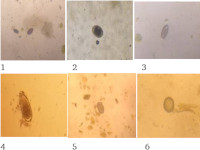Point prevalence of gastrointestinal parasites of game and captive wildlife in the Kumasi Metropolis, Ghana http://dx.doi.org/10.4314/njpar.v40i2.26
Main Article Content
Abstract
The ability to understand the ecological dynamics of parasites allows for a more wholistic insight into the application of the one health concept in wildlife medicine. Using this method, the ecological dynamics of shared gastrointestinal parasites of wildlife, humans and domestic animals in the Kumasi metropolis was determined. The study analyzed 102 faecal samples (59 from game and 43 from captive animals) from Kumasi Metropolis using the flotation and Mcmaster techniques. From the study, the pattern of prevalence for helminth parasites was same for both game and captive animals with Trichostrongyles being the most prevalent (49.2% in game animals and 44.2% in captive animals) followed by Ascarids, Stongyloides spp., and Trichuris spp. Capillaria spp. was least prevalent in captive animals at 23.3% and just a bit more prevalent in game animals (8.5%) than Trichuris spp. (5.1%). Protozoan parasite prevalence pattern differed between game and captive animals with Coccidia (45.8%) more prevalent in game animals than Entamoeba spp. (6.8%). In captive animals Entamoeba spp. (20.9%) was most prevalent followed by Coccidia (13.9%) and then Giardia spp. (11.6%). This confirmed the existence of shared gastrointestinal parasites between wildlife, humans and domestic animals with the potential to be spilled over into wildlife or spilled back to humans and domestic animals, emphasizing the need for more extensive studies in wildlife parasitology and ways in which to reduce the risks posed to humans, wildlife and our domestic animals.
Article Details

This work is licensed under a Creative Commons Attribution-NonCommercial-NoDerivatives 4.0 International License.
References
Berrian, A. M., van Rooyen, J., Martinez-Lopez, B., Knobel, D., Simpson, G. J. G., Wilkes, M. S. and Conrad, P. A. 2016 One health profile of a community at the wildlife-domestic animal interface, Mpumalanga, South Africa. Preventive Veterinary Medicine, 130: 119-128.
Holsback, L., Cardoso, M. L., Fagnani, R. and Patelli, T. H. C. 2012. Natural infection by endoparasites among free-living wild animals. Brazilian Journal of Veterinary Parasitology, 22(2): 302-306.
Jenkins, E. J., Simon, A., Bachand, N. and Stephen, C. 2015. Wildlife parasites in a One Health world. Trends in Parasitology, 31(5): 174-180.
Rhyan, J. C. and Spraker, T. R. 2010. Emergence of diseases from wildlife reservoirs. Veterinary Pathology, 47(1): 34-39.
Thompson, R. C. A., Lymbery, A. J. and Smith, A. 2010. Parasites, emerging disease and wildlife conservation. International Journal for Parasitology, 40(10): 1163- 1170.
Thompson, R. C. A. 2013. Parasite zoonosis and wildlife: One health, spillover and human activity. International Journal for Parasitology, 43(12-13): 1079-1088.
Danquah, E., Mac, N. E., Nteim, D. and Stephen, T. 2012. Prevalence and management of endo-parasitic zoonosis in the Kumasi Zoo, Ghana. International Journal of Biosciences, 2(8): 102-108.
Conboy, G. 1996. Diagnostic parasitology. Canadian Veterinary Journal, 37(3): 181-182.
Soulsby, E. J. L. 1982. Helminths, arthropods and protozoa of domesticated animals, 6th Edition. Baillier, Tindall and Casell, London.
Thienpont, D., Rochette, F.and Vanparijs, O. F.J. 1986. Diagnosing helminthiasis by coprological examination. (Ed. 2).
Rossanigo, C. E. and Gruner, L. 1995. Moisture and temperature requirements in feces for the development of free living stages of gastrointestinal nematodes of sheep and cattle and deer. Journal of Helminthology, 67: 357-362.
Opara, M. N., Osuji, C. T. and Opara, J. A. 2010. Gastrointestinal parasitism in captive animals at The Zoological Garden, Nekede, Owerri, south-east Nigeria. Report and Opinion, 2(5): 21-28.
Munene, E., Otsyula, M., Mbaabu, D. A. N., Mutahi, W. T., Murinki, S. M. K. and Muchemi, G. M. 1998. Helminthes and protozoan gastrointestinal tract parasites in captive and trapped African non-human primates. Veterinary Parasitology, 78: 195-20.
Weyher, A. H., Ross, C. and Semple, S. 2006 Gastrointestinal parasites in crop raiding and wild foraging Papio anubis in Nigeria. International Journal of Primatology, 27(6): 1519-1534.
Pourrut, X., Diffo, J. L. D., Somo, R. M., Bilong Bilong, C. F., Delaporte, E., LeBreton, M. and Gonzalez, J. P.2011. Prevalence of gastrointestinal parasites in primate bushmeat and pets in Cameroon. Veterinary Parasitology, 175(1-2): 187-191.
Freeman, A. S., Kinsella, J. M., Cipolletta, C., Deem, S. L. and Karesh, W. B. 2004. Endoparasites of western lowland gorillas (Gorilla gorilla gorilla) at Bai Hokou, Central African Republic. Journal of Wildlife Diseases, 40(4): 775-781.
Strait, K., Else, J. G. and Eberhard, M. L. 2012. Chapter 4 – Parasitic diseases of nonhuman primates. Nonhuman Primates in Biomedical Research (Second Edition), 197- 297.
Atanaskova, E., Kochevski, Z. and Nikolovski, G. 2011. Endoparasites in wild animals at the Zoological Garden in Skopje, Macedonia. Journal of Threatened Taxa,3(7): 1955-1958.


